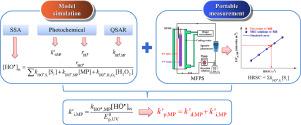Water Research ( IF 11.4 ) Pub Date : 2022-06-25 , DOI: 10.1016/j.watres.2022.118794 Yanyan Huang 1 , Zhimin Qiang 1 , Zhe Sun 2 , Mengkai Li 1

|
Ultraviolet-based advanced oxidation processes (UV-AOPs) are highly effective for micropollutant degradation. However, it is considerably time and labor consuming to evaluate the practical performance of UV-AOPs. This study developed a novel method, through combination of model simulation with portable measurement (MS-PM), to facilitate prediction of the photon fluence-based rate constant of micropollutant degradation (k′p,MP) by UV/H2O2, a commercially available UV-AOP. Model simulation was performed with photochemical, hydroxyl radical (HO•) concentration steady-state approximation, and quantitative structure-activity relationship models; and portable measurement was conducted on a mini-fluidic photoreaction system to quantify the HO• scavenging capacity (HRSC) of a water matrix. The method was established and further verified experimentally in seven test waters by taking sulfamethazine (SMN) as a model micropollutant. A lower k′p,SMN was predicted in a water matrix with a higher HRSC, for example, 57.5 and 347.8 m2 einstein–1 in the raw water (HRSC = 5.91 × 105 s–1) and sand-filtered effluent (HRSC = 5.25 × 104 s–1) of a drinking water treatment plant at an H2O2 dose of 25 mg L–1, respectively. The predicted values agreed generally well with the experimental ones. The MS-PM method has advantages of high efficiency and convenience, low cost, and acceptable accuracy, which will significantly facilitate the design and field assessment of UV-AOPs for micropollutant removal from drinking water.
中文翻译:

UV/H2O2 对饮用水中微污染物的降解:通过模型模拟和便携式测量相结合的促进预测
基于紫外线的高级氧化工艺 (UV-AOP) 对微污染物降解非常有效。然而,评估 UV-AOP 的实际性能是相当耗时的。本研究开发了一种新方法,通过将模型模拟与便携式测量 (MS-PM) 相结合,促进基于光子通量的UV/H 2 O 2微污染物降解速率常数 ( k ′ p,MP ) 的预测,市售的UV-AOP。模型模拟采用光化学、羟基自由基(H2O •) 浓度稳态近似和定量构效关系模型;并在微型流体光反应系统上进行便携式测量,以量化水基质的 H2O •清除能力 (HRSC)。以磺胺二甲嘧啶(SMN)为模型微污染物,在7个试验水域建立并进一步验证了该方法。在具有较高 HRSC 的水基质中预测较低的k ′ p,SMN,例如,在原水 (HRSC = 5.91 × 10 5 s –1 )和 沙滤出水 ( HRSC = 5.25 × 10 4秒–1) 的饮用水处理厂的 H 2 O 2剂量分别为 25 mg L –1。预测值与实验值基本一致。MS-PM 方法具有高效便捷、成本低、准确度可接受等优点,这将极大地促进用于去除饮用水中微量污染物的 UV-AOPs 的设计和现场评估。











































 京公网安备 11010802027423号
京公网安备 11010802027423号